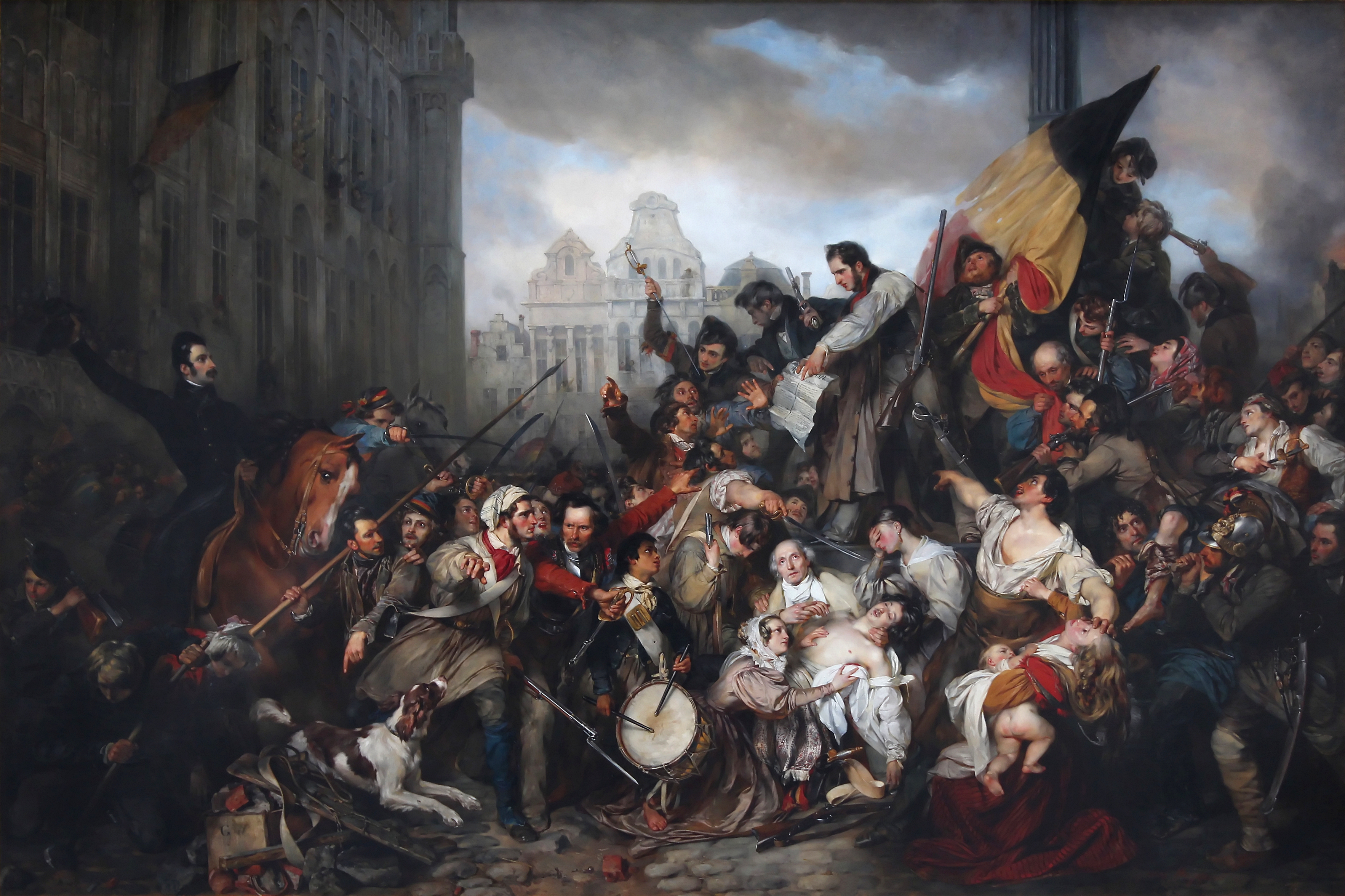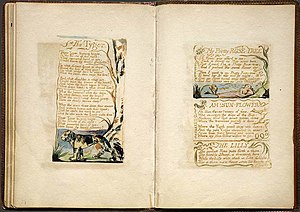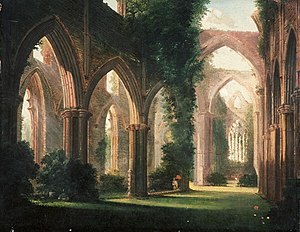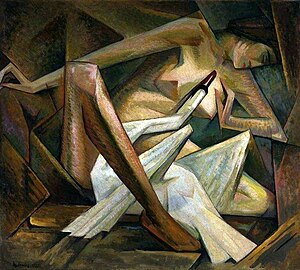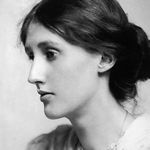ENGL 2122/Fall 2021/Schedule: Difference between revisions
m (Additions. Should I have intros to all major periods?) |
(Updated syllabus.) |
||
| Line 19: | Line 19: | ||
|- | |- | ||
! {{date|October 7}} | ! {{date|October 7}} | ||
| [[File:1794 William Blake Songs of Innocence.jpg|thumb]]'''William Blake''' {{bulleted list|From ''Songs of Innocence'': {{bulleted list|“Introduction”|“The Lamb”|“The Little Black Boy”|“The Chimney Sweeper”|“The Divine Image”}} |From ''Songs of Experience'': {{bulleted list|“Introduction”|“The Chimney Sweeper”|“The Tyger”|“The Sick Rose”|“London”}} }} | | [[File:1794 William Blake Songs of Innocence.jpg|thumb]]'''William Blake''' {{bulleted list|From ''Songs of Innocence'': {{bulleted list|“Introduction”|“The Lamb”|“The Little Black Boy”|“The Chimney Sweeper”|“The Divine Image”}} |From ''Songs of Experience'': {{bulleted list|“Introduction”|“The Chimney Sweeper”|“The Tyger”|“The Sick Rose”|“London”}}|Respond: Compare two poems, one from the ''Songs of Innocence'' and one from the ''Songs of Experience''. }} | ||
|- | |- | ||
! {{date|October 8}} | ! {{date|October 8}} | ||
| Line 28: | Line 28: | ||
|- | |- | ||
! {{date|October 12}} | ! {{date|October 12}} | ||
| '''Test #1''' | | '''Test #1''' and '''Response''' | ||
|- | |- | ||
| colspan="2" style="background-color:#d4e6f1; text-align:center;" | {{font|font=Alegreya Sans SC|size=24px|The Late Romantic Period}} | | colspan="2" style="background-color:#d4e6f1; text-align:center;" | {{font|font=Alegreya Sans SC|size=24px|The Late Romantic Period}} | ||
| Line 39: | Line 39: | ||
|- | |- | ||
! {{date|October 15}} | ! {{date|October 15}} | ||
| [[File:John Keats, portrait by Joseph Severn.jpg|Joseph Severn, ''Portrait of John Keats''|thumb]]'''John Keats''' {{bulleted list| | | [[File:John Keats, portrait by Joseph Severn.jpg|Joseph Severn, ''Portrait of John Keats''|thumb]]'''John Keats''' {{bulleted list|“[[June 9, 2021|On First Looking into Chapman’s Homer]]”|“La Belle Dame Sans Merci”|“When I have fears that I may cease to be”|“Ode to a Nightingale”|“Ode to a Grecian Urn”}} | ||
|- | |- | ||
! {{date|October 18}} | ! {{date|October 18}} | ||
| Line 45: | Line 45: | ||
|- | |- | ||
! {{date|October 19}} | ! {{date|October 19}} | ||
| '''Test #2''' | | '''Test #2''' and '''Response''' | ||
|- | |- | ||
| colspan="2" style="background-color:#d4efdf; text-align:center;" | {{font|font=Alegreya Sans SC|size=24px|The Victorian Period}} | | colspan="2" style="background-color:#d4efdf; text-align:center;" | {{font|font=Alegreya Sans SC|size=24px|The Victorian Period}} | ||
|- | |- | ||
! {{date|October 20}} | ! {{date|October 20}} | ||
| | | '''Introduction to Victorian Literature''' {{bulleted list|Editor’s Introduction, pp. 527–551|Respond: Based on your reading, identify the five most important characteristics that define the Victorian Age. Who are the major figures? Major works? What should readers look for in the work?}} | ||
|- | |- | ||
! {{date|October 21}} | ! {{date|October 21}} | ||
| ''' | | [[File:Lady of Shalott.jpg|Waterhouse, ''The Lady of Shalott''|thumb]]'''Alfred, Lord Tennyson''' {{bulleted list|“The Lady of Shalott”|“The Lotos-Eaters”|“Ulysses”}} '''Gerard Manley Hopkins''' {{bulleted list|“God’s Grandeur”|“The Windhover”}} | ||
|- | |- | ||
! {{date|October 22}} | ! {{date|October 22}} | ||
| ''' | | '''Robert Browning''' {{bulleted list|“My Last Duchess”|“Porphyria’s Lover” }} '''Matthew Arnold''' {{bulleted list|“Dover Beach”|From ''The Study of Poetry'' }} '''Christina Rossetti''' {{bulleted list|“Goblin Market”}} | ||
|- | |- | ||
! {{date|October 25}} | ! {{date|October 25}} | ||
| Line 62: | Line 62: | ||
|- | |- | ||
! {{date|October 26}} | ! {{date|October 26}} | ||
| '''Test #3''' | | '''Test #3''' and '''Response''' | ||
|- | |- | ||
| colspan="2" style="background-color:#fcf3cf; text-align:center;" | {{font|font=Alegreya Sans SC|size=24px| | | colspan="2" style="background-color:#fcf3cf; text-align:center;" | {{font|font=Alegreya Sans SC|size=24px|Victorian / Edwardian / World War I}} | ||
|- | |- | ||
! {{date|October 27}} | ! {{date|October 27}} | ||
| ''' | | '''Introduction to the Twentieth Century''' {{bulleted list|Editor’s Introduction, pp. 1015–1042|Respond: Based on your reading, identify the five most important characteristics that define the the turn of the century’s trends in literature. Who are the major figures? Major works? What should readers look for in works of this period?}} | ||
|- | |- | ||
! {{date|October 28}} | ! {{date|October 28}} | ||
| ''' | | '''Rudyard Kipling''' {{bulleted list|“The Man Who Would Be King”}} | ||
|- | |- | ||
! {{date|October 29}} | ! {{date|October 29}} | ||
| '''James Joyce''' {{bulleted list|“Araby”}} | | '''E. M. Forster''' {{bulleted list|“The Machine Stops”|“[[August 7, 2021|Tolerance]]”}} '''James Joyce''' {{bulleted list|“Araby”}} | ||
|- | |- | ||
! {{date|November 1}} | ! {{date|November 1}} | ||
| '''Rupert Brooke''' {{bulleted list|“The Soldier”}} ''' | | '''Rupert Brooke''' {{bulleted list|“The Soldier”}} '''Siegfried Sassoon''' {{bulleted list |[[lw:“They”|‘They’]]”|“[[lw:The Rear Guard|The Rear Guard]]”|“[[lw:The General|The General]]”|“[[lw:Glory of Women|Glory of Women]]”}} '''Wilfred Owen''' {{bulleted list|“Anthem for a Doomed Youth”|“Dulce Et Decorum Est”|“Apologia Pro Poemate Meo”}} | ||
|- | |- | ||
! {{date|November 2}} | ! {{date|November 2}} | ||
| '''Test #4''' | | '''Test #4''' and '''Response''' | ||
|- | |- | ||
| colspan="2" style="background-color:#fae5d3; text-align:center;" | {{font|font=Alegreya Sans SC|size=24px|Modernism}} | | colspan="2" style="background-color:#fae5d3; text-align:center;" | {{font|font=Alegreya Sans SC|size=24px|Modernism}} | ||
| Line 90: | Line 90: | ||
|- | |- | ||
! {{date|Nov 5}}{{refn|Withdrawal deadline.}} | ! {{date|Nov 5}}{{refn|Withdrawal deadline.}} | ||
| '''W. H. Auden''' {{bulleted list|“Musée des Beaux Arts”}} '''Dylan Thomas''' {{bulleted list|“Do Not Go Gentle into that | | '''W. H. Auden''' {{bulleted list|“Musée des Beaux Arts”}} '''Dylan Thomas''' {{bulleted list|“Do Not Go Gentle into that Good Night”}} | ||
|- | |- | ||
! {{date|Nov 8}} | ! {{date|Nov 8}} | ||
| Line 96: | Line 96: | ||
|- | |- | ||
! {{date|Nov 9}} | ! {{date|Nov 9}} | ||
| '''Test #5''' | | '''Test #5''' and '''Response''' | ||
|- | |- | ||
| colspan="2" style="background-color:#e8daef; text-align:center;" | {{font|font=Alegreya Sans SC|size=24px|World War II / Postmodernism}} | | colspan="2" style="background-color:#e8daef; text-align:center;" | {{font|font=Alegreya Sans SC|size=24px|World War II / Postmodernism}} | ||
|- | |- | ||
! {{date|Nov 10}} | ! {{date|Nov 10}} | ||
| '''Philip Larkin''' {{bulleted list|“[[May 15, 1996|The Mower]]”|“Talking in Bed”}} | | '''Philip Larkin''' {{bulleted list|“[[May 15, 1996|The Mower]]”|“Talking in Bed”}} '''Seamus Heany''' {{bulleted list|“Digging”|“Clearances”|“Punishment”|“The Skunk” }} | ||
|- | |- | ||
! {{date|Nov 11}} | ! {{date|Nov 11}} | ||
| Line 107: | Line 107: | ||
|- | |- | ||
! {{date|Nov 12}} | ! {{date|Nov 12}} | ||
| ''' | | '''Margaret Atwood''' {{bulleted list|“Death by Landscape” }} | ||
|- | |- | ||
! {{date|Nov 15}} | ! {{date|Nov 15}} | ||
| ''' | | '''Salman Rushdie''' {{bulleted list|“The Prophet’s Hair”}} | ||
|- | |- | ||
! {{date|Nov 29}} | ! {{date|Nov 29}} | ||
| Line 116: | Line 116: | ||
|- | |- | ||
! {{date|Nov 30}} | ! {{date|Nov 30}} | ||
| '''Test #6''' | | '''Test #6''' and '''Response''' | ||
|} | |} | ||
Revision as of 07:24, 10 August 2021
TL;DR: This schedule is tentative and subject to change. This is a digital document; do not print. Students are responsible for getting updates. |
This schedule represents the ideal outline for our study this semester. Yet, like all best-laid plans, we may not be able to keep up with our agenda. Please be flexible and try to look and read ahead whenever possible.
We will do our best to stick by this schedule, but I will inform you verbally, via an email, and/or a literal change to the schedule below whenever there is a deviation. Getting these updates is solely your responsibility. Therefore, this schedule is tentative and subject to change contingent upon the needs of the students and the professor, and dictated by time and other constraints which may affect the course. For face-to-face classes, this schedule reflects only an overview of the assigned reading and other major course assignments. It may not indicate specific class session assignments or activities. Specific in-class assignments may not be reflected on the schedule.
Each week of this class has its own unit or lesson corresponding to a literary movement. Each week is divided into daily work that contain readings (with the occasional reading quiz) and writing. Each week concludes with a test on the materials covered. The following is a general overview of the schedule.
Before beginning your work each week, read through the whole lesson so you know what to expect and understand what’s expected. Each tab corresponds to a lesson. All assignments are contained therein. Any questions should be posted to the class forum, and be sure to read my weekly feedback. |
| Date | Assignment |
|---|---|
| The Early Romantic Period | |
| 6 October | Introduction to Romanticism
|
| 7 October | William Blake
|
| 8 October | William Wordsworth
|
| 11 October | Mary Wollstonecraft Shelley
|
| 12 October | Test #1 and Response |
| The Late Romantic Period | |
| 13 October | George Gordon, Lord Byron
|
| 14 October | Percy Bysshe Shelley
|
| 15 October | John Keats
|
| 18 October | Elizabeth Barrett Browning
|
| 19 October | Test #2 and Response |
| The Victorian Period | |
| 20 October | Introduction to Victorian Literature
|
| 21 October | Alfred, Lord Tennyson
|
| 22 October | Robert Browning
|
| 25 October | Oscar Wilde
|
| 26 October | Test #3 and Response |
| Victorian / Edwardian / World War I | |
| 27 October | Introduction to the Twentieth Century
|
| 28 October | Rudyard Kipling
|
| 29 October | E. M. Forster
|
| 1 November | Rupert Brooke
|
| 2 November | Test #4 and Response |
| Modernism | |
| 3 November[1] | William Butler Yeats
|
| 4 November | T. S. Eliot
|
| 5 November[2] | W. H. Auden
|
| 8 November | Virginia Woolf
|
| 9 November | Test #5 and Response |
| World War II / Postmodernism | |
| 10 November | Philip Larkin
|
| 11 November | Nadine Gordimer
|
| 12 November | Margaret Atwood
|
| 15 November | Salman Rushdie
|
| 29 November | Ishiguro
|
| 30 November | Test #6 and Response |
notes
| 🕒 08-10-2021 | 📆 Make an Appointment | 💬 Ask a Question | 📣 Leave Feedback |
